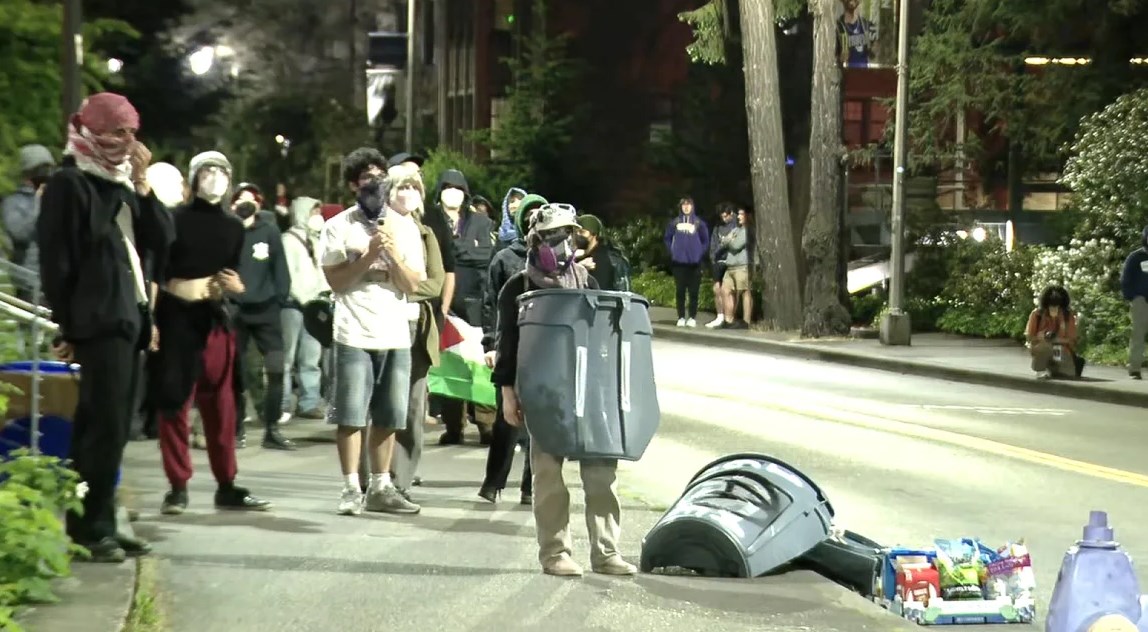More than 30 pro-Palestinian protesters were arrested after occupying a Boeing-funded engineering building at the University of Washington.
The demonstration, organized by a student group, condemned Boeing’s role in Gaza and demanded action from the university.
Fires were set, streets blocked, and tensions ran high before police intervened.
Content Highlights
- Event: Protesters occupy Interdisciplinary Engineering Building at the University of Washington
- Trigger: Boeing’s $10M donation and defense contracts linked to Gaza conflict
- Arrests: Over 30 individuals detained on charges including trespassing, disorderly conduct
- Actions Taken: Dumpster fires set, building entrances blocked
- Organizers: SUPER UW, a suspended pro-Palestinian student group
- Demands: Cut university ties with Boeing; rename the building after a Gaza victim
- Response: Strong police presence; university condemns protest as antisemitic

In a powerful and emotionally charged demonstration that echoed the grief and fury of global conflict, more than 30 pro-Palestinian protesters were arrested Monday night after taking over the University of Washington’s Interdisciplinary Engineering Building — a structure deeply tied to defense contractor Boeing.
This wasn’t just an occupation. It was a cry for recognition, for remembrance, and for justice.
A Protest Rooted in Legacy and Grief
The protest, organized by the suspended student group Students United for Palestinian Equality and Return (SUPER UW), was more than a sit-in — it was a tribute.
A banner fluttered from the second-floor window, bearing the name of a young engineering student reportedly killed in an airstrike in Gaza.
Demonstrators called for the building to be renamed in the student’s honor, transforming the space into a memorial to lives lost.
Their pain was visceral, their voices urgent.
“We demand our university divest from Boeing,” their manifesto read.
“We demand accountability. We demand humanity.”
Fires of Frustration and a Call for Accountability
As dusk fell, tensions escalated.
Protesters — many with faces covered, urged by organizers to conceal identifiable features — blocked surrounding streets, barricaded entrances, and ignited dumpster fires outside the building.
These weren’t acts of random rebellion, but visible expressions of outrage against what they see as complicity in violence abroad.
The building, part-funded by Boeing’s $10 million donation, has become a symbol of corporate influence in academic spaces — a partnership that these students refuse to accept in silence.
A Legacy Confronted by Law Enforcement
By 10:30 p.m., a coalition of officers — including campus police, Seattle police, and Washington State Patrol’s Rapid Deployment Teams — began clearing the scene.
Protesters were led out, one by one, as chants of solidarity echoed in the background.
Each arrest, each step, was part of a moment that many will remember not just for its chaos, but for its message.
University spokesperson Victor Balta confirmed around 30 arrests.
Charges included trespassing, property destruction, and conspiracy.
Balta emphasized that students would also be referred to the Student Conduct Office.
“The University will not be intimidated by this sort of offensive and destructive behavior,” he said, calling the group’s statements “antisemitic.”
The Movement Behind the Fire
SUPER UW, although suspended by the university, has been a persistent voice on campus.
Their February march against Boeing ties drew 150 attendees.
Now, their occupation has brought their cause back to national attention — and with it, fresh scrutiny.
The group’s rhetoric — controversial and intense — reflects a student movement trying to navigate the grief of international conflict, institutional resistance, and generational trauma.
Their manifesto, which has drawn criticism for praising Hamas’ October 7 attacks, speaks to the complicated narratives that have fueled protest across U.S. campuses.
A Campus Shaped by Protest
The University of Washington, like many schools across the nation, has seen its fair share of demonstrations.
A year ago, an encampment in support of Palestine lasted for weeks until it was dismantled amid allegations of antisemitic and violent graffiti.
Now, once again, the campus finds itself at the intersection of activism and accountability, of legacy and law.
And while the building may stand as a monument to industry and innovation, to the students who stood within it Monday night — it also stands as a battlefield for remembrance, for justice, and for those whose voices are too often silenced.